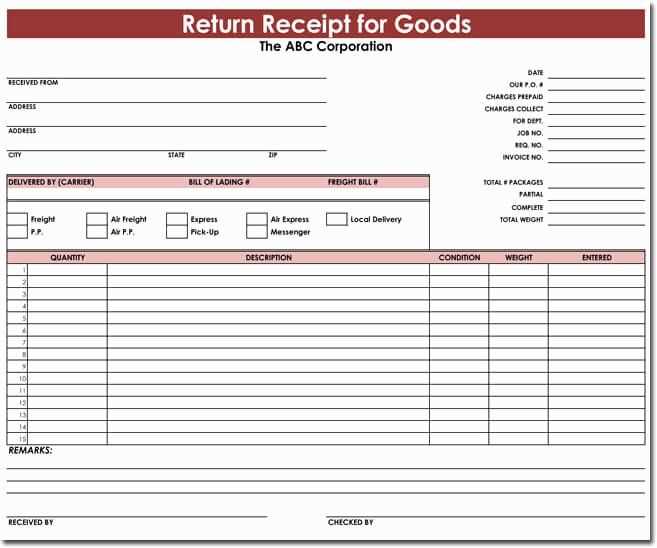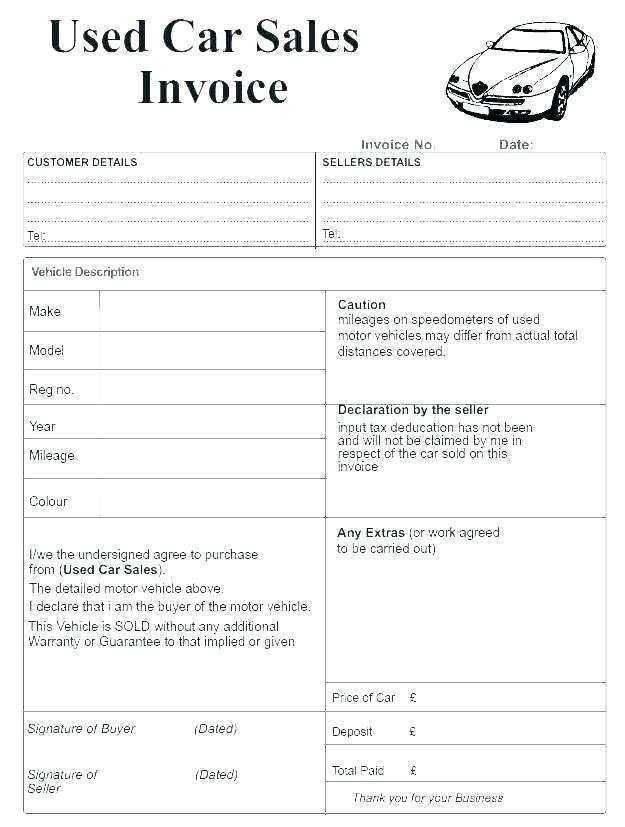
When purchasing a used car, having a clear and accurate receipt is key for both the buyer and seller. This document serves as proof of transaction and provides necessary details regarding the sale. It should include basic information such as the vehicle’s make, model, and VIN, as well as the sale price and date. Both parties must sign to validate the transaction.
To avoid any confusion, include specific clauses about the condition of the car and whether any warranties or guarantees are offered. Clearly state that the car is being sold “as is” if there are no warranties. This helps prevent future disputes. Also, make sure to note whether a deposit was paid, the payment method, and any terms for payment installments.
For smooth future reference, keep a copy of the receipt for your records. Having a receipt that is thorough and transparent can save both the buyer and seller from unnecessary complications down the line. Remember, it’s better to be detailed than vague, as this will protect both parties in case of any legal questions that arise later.
Used Car Purchase Receipt Template
For a smooth transaction, use a used car purchase receipt to document the details of the sale. Include the buyer’s and seller’s full names, addresses, and contact information. Clearly state the vehicle’s make, model, year, Vehicle Identification Number (VIN), and mileage at the time of sale. The date of the transaction and the total sale amount should also be included, along with any deposits or down payments made prior to the sale.
Specify the payment method (cash, check, or bank transfer) and note any warranties or conditions attached to the vehicle, such as if the sale is “as is” or if any repairs are promised. Both parties should sign the receipt to confirm their agreement to the terms. Ensure that both the buyer and seller retain a copy for their records.
How to Include Buyer and Seller Information
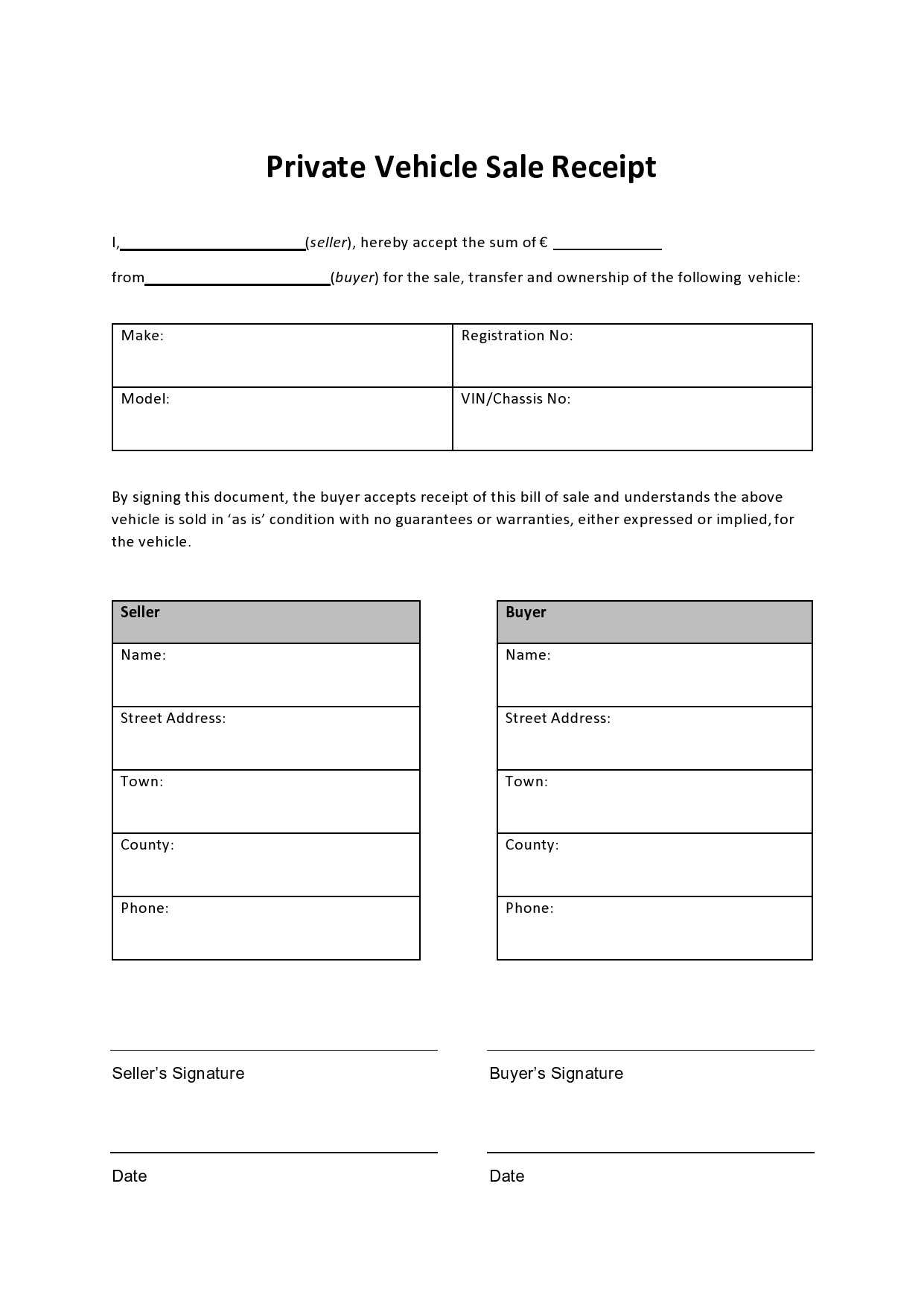
To ensure the accuracy of the used car purchase receipt, clearly list both the buyer and seller details. Start by including full names, addresses, and contact numbers. This information helps confirm the identities of both parties and provides a reference point if any issues arise later.
Buyer Information
List the buyer’s full legal name as it appears on their identification documents. Include the buyer’s home address, phone number, and email address for future communication. It’s crucial to be as specific as possible to avoid any confusion later.
Seller Information
The seller’s details should mirror the buyer’s section. Include their full legal name, address, and contact details. If the seller is a dealership, include the business name, address, and contact details rather than individual information.
| Buyer’s Name | Buyer’s Address | Buyer’s Contact Number | Seller’s Name | Seller’s Address | Seller’s Contact Number |
|---|---|---|---|---|---|
| John Doe | 1234 Maple St, City, ZIP | (555) 123-4567 | Jane Smith | 5678 Oak Rd, City, ZIP | (555) 987-6543 |
Double-check all details for accuracy. Mistakes can lead to confusion or disputes down the line. Having clear, complete information protects both the buyer and seller in the transaction.
Essential Details About the Vehicle
Include the vehicle’s make, model, year of manufacture, and Vehicle Identification Number (VIN). These details verify the car’s identity and establish its uniqueness. It’s crucial to double-check these against the documents provided by the seller to avoid any discrepancies.
Vehicle Make and Model
The make and model give you insight into the manufacturer and type of vehicle you’re purchasing. These details are key for identifying the car’s value and confirming that it matches the seller’s description.
Year of Manufacture
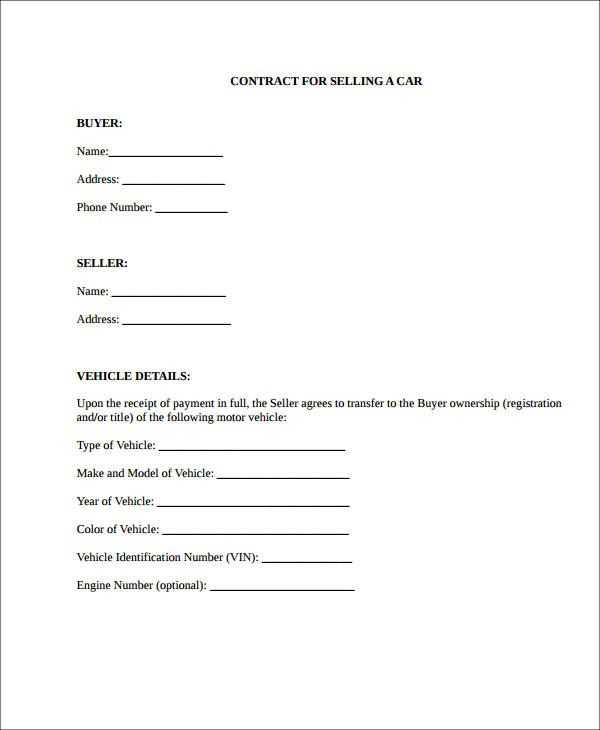
Note the year the vehicle was made. This affects its age and can give you an idea of potential wear and tear, as well as expected maintenance costs.
Vehicle Identification Number (VIN)
The VIN serves as the car’s fingerprint. Verify it by comparing the number on the vehicle and its title to ensure they match. A VIN check can also confirm whether the car has been reported stolen or involved in major accidents.
Mileage
Record the current mileage, as this directly impacts the car’s value. Ensure it aligns with the car’s age and condition. If the mileage seems unusually low or high, ask the seller for clarification.
Previous Ownership and Service History
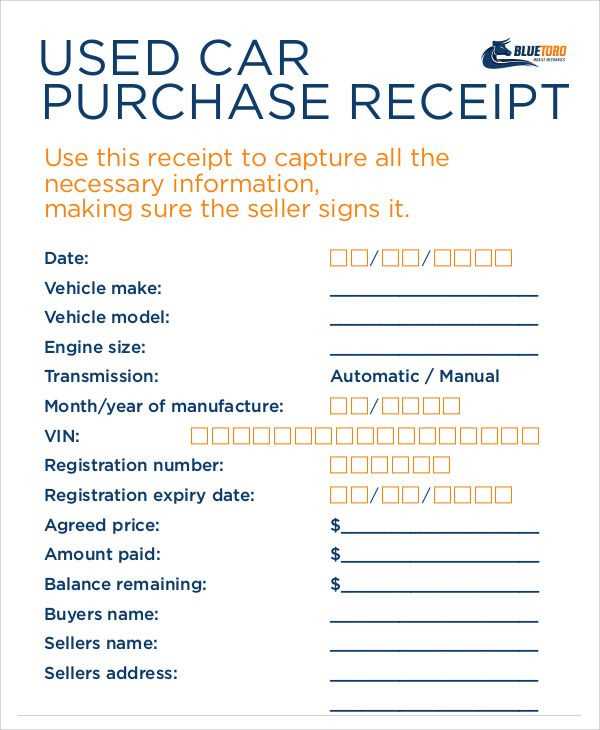
Request the service records and any history of previous ownership. This shows how well the vehicle was maintained and if there were any major repairs or accidents.
Payment Terms and Amount
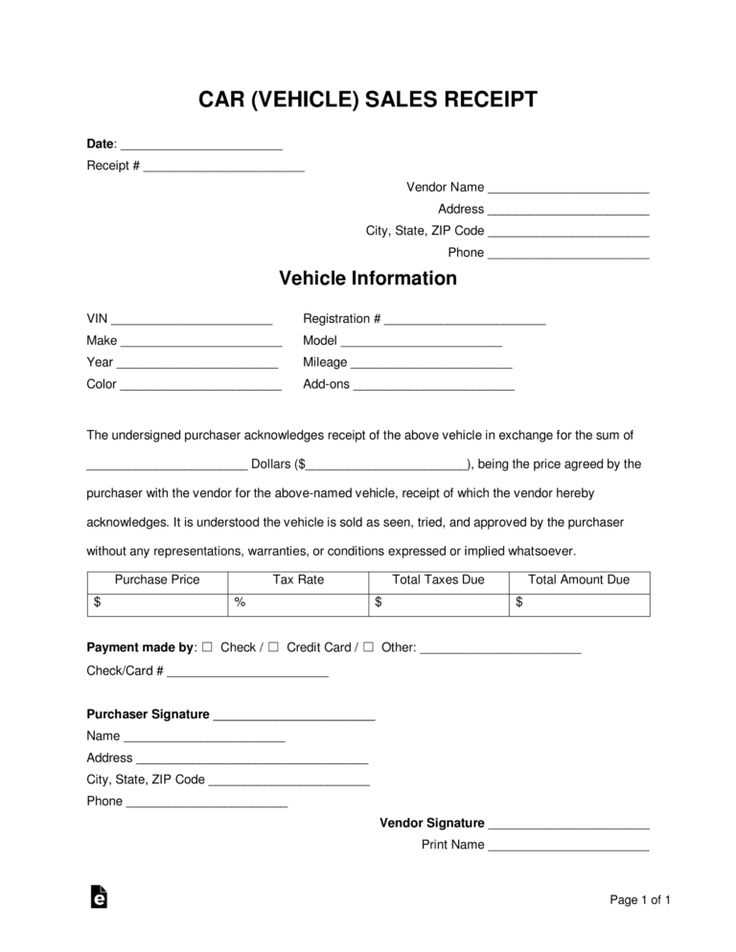
The payment amount should be clearly stated in the receipt, specifying the total sum the buyer has agreed to pay for the vehicle. This includes the purchase price, any additional fees, and taxes, if applicable. Make sure to list the exact currency and format the amount clearly to avoid confusion.
Payment Methods
Specify the payment method used by the buyer. Common options include cash, bank transfer, or checks. If an installment plan is agreed upon, outline the terms: the initial deposit, the remaining balance, and any interest rates applied. This section should cover any deadlines or payment schedules, ensuring transparency on both sides.
Late Payment Penalties
If there are any penalties for delayed payments, include the specific charges and timelines. Clearly define when payments are considered overdue and the additional costs that will apply after a certain period, such as a late fee or interest rate.
Transfer of Ownership Clause
The Transfer of Ownership Clause is a critical part of any used car purchase receipt. It ensures that the buyer officially assumes ownership of the vehicle and is responsible for its legal and financial matters moving forward. This clause should be clear and precise to prevent any misunderstandings between the buyer and the seller.
Make sure to include the following details in the clause:
- Date of Transfer: Specify the exact date when the ownership is transferred.
- Buyer’s Details: Include the full name and address of the buyer for identification purposes.
- Seller’s Details: Include the full name and address of the seller.
- Vehicle Information: Include the vehicle’s make, model, year, VIN (Vehicle Identification Number), and current registration details.
- Statement of Transfer: Clearly state that the seller is transferring all ownership rights and responsibilities to the buyer.
It’s advisable to state that the seller affirms that the car is free of any liens or legal disputes, ensuring the buyer receives full ownership. The clause can also specify if the buyer accepts the car “as is,” meaning without any guarantees of future repairs or modifications.
Lastly, both parties should sign the receipt in the presence of a witness, adding legal weight to the transfer process. This step will help avoid any issues in case the ownership is questioned in the future.
Conditions for Vehicle Inspection and Test Drive
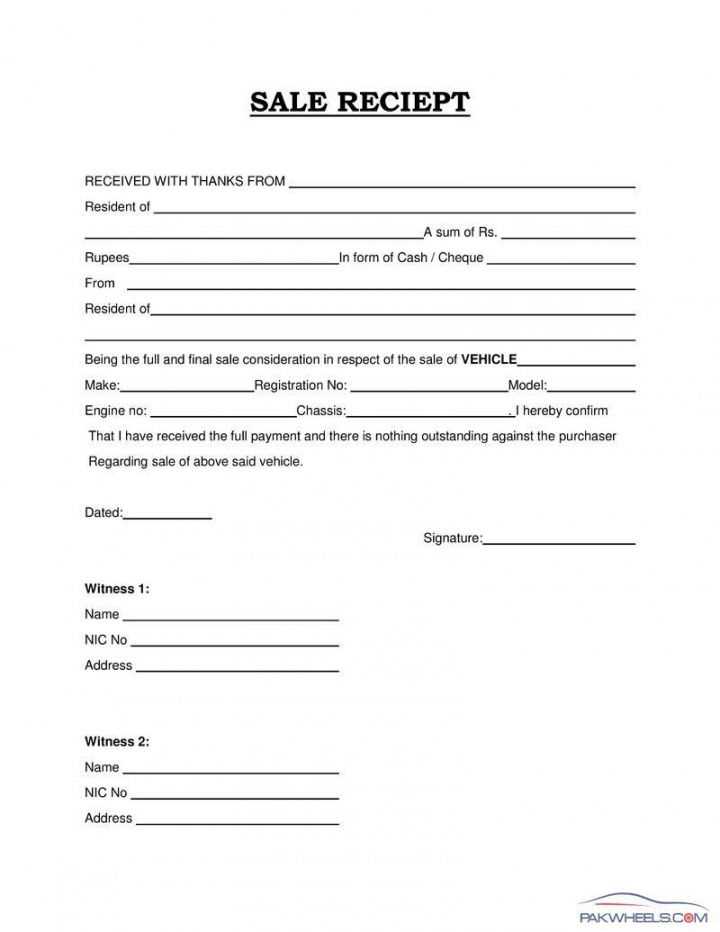
Schedule the vehicle inspection and test drive during daylight hours. Inspect the car in good lighting to spot any issues with the exterior, such as scratches or dents. Ensure the vehicle is parked on level ground for a thorough inspection of the tires, suspension, and undercarriage.
Before the test drive, check that the car has valid insurance and registration documents. Bring your driver’s license and make sure the seller accompanies you. Start the engine and listen for unusual sounds. Pay attention to the steering, brakes, and responsiveness of the vehicle. Test all features, including lights, air conditioning, and the infotainment system, to confirm they function correctly.
On the road, test the car’s acceleration, handling, and braking at various speeds. Drive on different surfaces if possible, such as highways and residential streets. Check for smooth gear shifts and comfortable suspension. Be alert for any vibrations or noises that could signal mechanical issues.
If the vehicle passes the test drive and inspection, request a professional mechanic’s assessment before finalizing the purchase to verify the condition. This step can prevent unexpected repair costs after buying the car.
Legal Notices and Warranty Information
Ensure the used car purchase receipt clearly outlines any legal disclaimers related to the sale. Specify whether the car is sold “as is” or if there are any warranties or guarantees included. A well-structured receipt should explicitly state that the buyer acknowledges the car’s condition at the time of sale. If a warranty is provided, detail its coverage, duration, and any exclusions that may apply.
If the vehicle comes with a manufacturer’s warranty, specify the remaining warranty period and the steps the buyer must take for claims. For used cars with no warranty, it’s beneficial to clearly note that the buyer assumes responsibility for repairs. Include the contact details for any after-sale service or claims management if applicable.
Incorporate a section that outlines the buyer’s rights under local consumer protection laws, especially in case of misrepresentation or hidden defects. This protects both parties and ensures transparency in the transaction.

